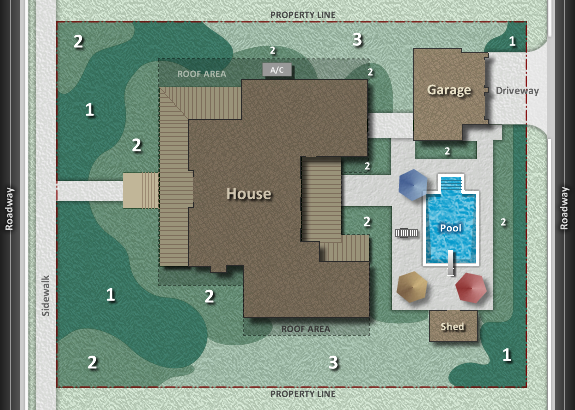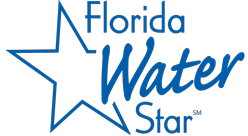Sprinkler irrigation
- Home
- /
- Technical Manual
- /
- Irrigation system criteria
- /
- General design
- /
- Sprinkler irrigation
Background
Sprinkler irrigation is any sprinkler or emitter with a flow rate of 30 gallons per hour (gph) or 0.5 gallons per minute (gpm) or greater. In most cases, high-volume irrigation devices are spray and rotor sprinklers. Low-volume irrigation is typically referred to as microirrigation. Bubblers usually have flow rates at or above 0.5 gpm and, for the purposes of this program, they are considered high-volume irrigation. Sprinkler is used to irrigate turf grass and other plant materials having a greater watering requirement.
Florida Water Star requires reduced high-volume irrigation for the following reasons:
High precipitation rate irrigation: The volume of water applied is derived from a combination of the precipitation rate and run time of the sprinkler/emitter. As volume is also dependent on run time, the term high-volume denotes high precipitation rate devices. High precipitation rates create the potential for high water use when poor scheduling practices are used, which is common in Florida. Additionally, excess irrigation water can result in stormwater runoff.
Application efficiency: High-volume (high precipitation rate) irrigation devices have lower application efficiencies in comparison with microirrigation. In other words, a microirrigation emitter uses less water to effectively deliver the amount of water necessary to meet a plant’s water requirement.

By reducing the area of the landscape that requires high-volume irrigation and using microirrigation or no irrigation after establishment, the demand for irrigation water can be reduced significantly. In Florida, high-volume irrigation is frequently run for longer periods than necessary, resulting in overwatering. Reducing the amount of high-volume irrigation area and subsequent high-volume irrigation can reduce total irrigation application. Opting for microirrigation or no irrigation is driven by the landscape design. In most situations, decreasing high-volume irrigation is accomplished by reducing the area covered by turf grass when planning the landscape design.
Requirements and certification
Sprinkler areas are limited to the following percentages for each level of Florida Water Star Residential certification:
- Silver: 60%
- Gold: 50%
Points are awarded in all residential certification tiers for installing a percentage of high-volume irrigation that is below the high-volume limit. The total irrigated area on a Florida Water Star Residential project cannot exceed one-half acre. No high-volume percentage restriction exists for the Florida Water Star Commercial/Institutional certification or the common areas of Community certification. The water budget for Commercial/Institutional certification addresses high-volume irrigation.
Silver and Gold requirements
| Percentage of Landscape | Silver | Gold | Commercial/ Institutional |
|---|---|---|---|
| 60 | Required | NA | NA |
| 50 | NA | Required | |
| 41–50 | NA | 5 points | |
| 31–40 | NA | 10 points | |
| Less than 30 | NA | 15 points | |
| No high-volume | NA | 30 points |
The irrigation drawing should clearly indicate the area (in square feet) of high-volume irrigation. The Inspector should field-verify the percentage of high-volume irrigation. The percentage of high-volume irrigation area is calculated as a percentage of the entire landscaped area.
| High-Volume Irrigation Percentage Calculation |
|---|
| total high-volume irrigation area ÷ total landscaped area |
Program tip
To meet this requirement, there must be communication among the landscape and irrigation contractors to ensure the high-volume irrigation area does not exceed the percent requirement. The percentage threshold is precisely interpreted, and variances are prohibited.
Precipitation rates for sprinklers are listed in the manufacturer’s product manual and can often be found on the company’s or distributor’s website.
